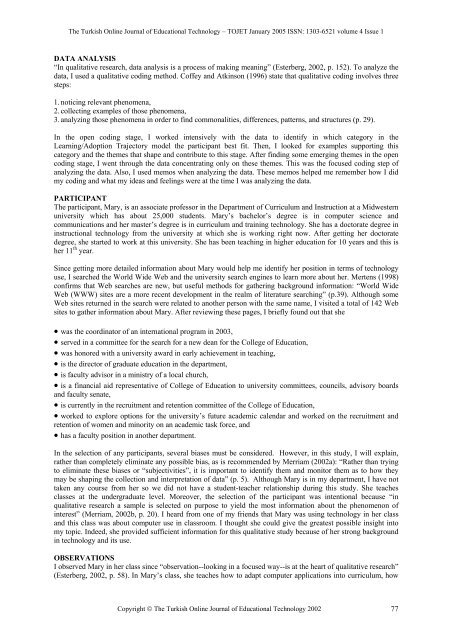Age - TOJET the Turkish online journal of educational technology
Age - TOJET the Turkish online journal of educational technology
Age - TOJET the Turkish online journal of educational technology
Create successful ePaper yourself
Turn your PDF publications into a flip-book with our unique Google optimized e-Paper software.
The <strong>Turkish</strong> Online Journal <strong>of</strong> Educational Technology – <strong>TOJET</strong> January 2005 ISSN: 1303-6521 volume 4 Issue 1<br />
DATA ANALYSIS<br />
“In qualitative research, data analysis is a process <strong>of</strong> making meaning” (Esterberg, 2002, p. 152). To analyze <strong>the</strong><br />
data, I used a qualitative coding method. C<strong>of</strong>fey and Atkinson (1996) state that qualitative coding involves three<br />
steps:<br />
1. noticing relevant phenomena,<br />
2. collecting examples <strong>of</strong> those phenomena,<br />
3. analyzing those phenomena in order to find commonalities, differences, patterns, and structures (p. 29).<br />
In <strong>the</strong> open coding stage, I worked intensively with <strong>the</strong> data to identify in which category in <strong>the</strong><br />
Learning/Adoption Trajectory model <strong>the</strong> participant best fit. Then, I looked for examples supporting this<br />
category and <strong>the</strong> <strong>the</strong>mes that shape and contribute to this stage. After finding some emerging <strong>the</strong>mes in <strong>the</strong> open<br />
coding stage, I went through <strong>the</strong> data concentrating only on <strong>the</strong>se <strong>the</strong>mes. This was <strong>the</strong> focused coding step <strong>of</strong><br />
analyzing <strong>the</strong> data. Also, I used memos when analyzing <strong>the</strong> data. These memos helped me remember how I did<br />
my coding and what my ideas and feelings were at <strong>the</strong> time I was analyzing <strong>the</strong> data.<br />
PARTICIPANT<br />
The participant, Mary, is an associate pr<strong>of</strong>essor in <strong>the</strong> Department <strong>of</strong> Curriculum and Instruction at a Midwestern<br />
university which has about 25,000 students. Mary’s bachelor’s degree is in computer science and<br />
communications and her master’s degree is in curriculum and training <strong>technology</strong>. She has a doctorate degree in<br />
instructional <strong>technology</strong> from <strong>the</strong> university at which she is working right now. After getting her doctorate<br />
degree, she started to work at this university. She has been teaching in higher education for 10 years and this is<br />
her 11 th year.<br />
Since getting more detailed information about Mary would help me identify her position in terms <strong>of</strong> <strong>technology</strong><br />
use, I searched <strong>the</strong> World Wide Web and <strong>the</strong> university search engines to learn more about her. Mertens (1998)<br />
confirms that Web searches are new, but useful methods for ga<strong>the</strong>ring background information: “World Wide<br />
Web (WWW) sites are a more recent development in <strong>the</strong> realm <strong>of</strong> literature searching” (p.39). Although some<br />
Web sites returned in <strong>the</strong> search were related to ano<strong>the</strong>r person with <strong>the</strong> same name, I visited a total <strong>of</strong> 142 Web<br />
sites to ga<strong>the</strong>r information about Mary. After reviewing <strong>the</strong>se pages, I briefly found out that she<br />
• was <strong>the</strong> coordinator <strong>of</strong> an international program in 2003,<br />
• served in a committee for <strong>the</strong> search for a new dean for <strong>the</strong> College <strong>of</strong> Education,<br />
• was honored with a university award in early achievement in teaching,<br />
• is <strong>the</strong> director <strong>of</strong> graduate education in <strong>the</strong> department,<br />
• is faculty advisor in a ministry <strong>of</strong> a local church,<br />
• is a financial aid representative <strong>of</strong> College <strong>of</strong> Education to university committees, councils, advisory boards<br />
and faculty senate,<br />
• is currently in <strong>the</strong> recruitment and retention committee <strong>of</strong> <strong>the</strong> College <strong>of</strong> Education,<br />
• worked to explore options for <strong>the</strong> university’s future academic calendar and worked on <strong>the</strong> recruitment and<br />
retention <strong>of</strong> women and minority on an academic task force, and<br />
• has a faculty position in ano<strong>the</strong>r department.<br />
In <strong>the</strong> selection <strong>of</strong> any participants, several biases must be considered. However, in this study, I will explain,<br />
ra<strong>the</strong>r than completely eliminate any possible bias, as is recommended by Merriam (2002a): “Ra<strong>the</strong>r than trying<br />
to eliminate <strong>the</strong>se biases or “subjectivities”, it is important to identify <strong>the</strong>m and monitor <strong>the</strong>m as to how <strong>the</strong>y<br />
may be shaping <strong>the</strong> collection and interpretation <strong>of</strong> data” (p. 5). Although Mary is in my department, I have not<br />
taken any course from her so we did not have a student-teacher relationship during this study. She teaches<br />
classes at <strong>the</strong> undergraduate level. Moreover, <strong>the</strong> selection <strong>of</strong> <strong>the</strong> participant was intentional because “in<br />
qualitative research a sample is selected on purpose to yield <strong>the</strong> most information about <strong>the</strong> phenomenon <strong>of</strong><br />
interest” (Merriam, 2002b, p. 20). I heard from one <strong>of</strong> my friends that Mary was using <strong>technology</strong> in her class<br />
and this class was about computer use in classroom. I thought she could give <strong>the</strong> greatest possible insight into<br />
my topic. Indeed, she provided sufficient information for this qualitative study because <strong>of</strong> her strong background<br />
in <strong>technology</strong> and its use.<br />
OBSERVATIONS<br />
I observed Mary in her class since “observation--looking in a focused way--is at <strong>the</strong> heart <strong>of</strong> qualitative research”<br />
(Esterberg, 2002, p. 58). In Mary’s class, she teaches how to adapt computer applications into curriculum, how<br />
Copyright © The <strong>Turkish</strong> Online Journal <strong>of</strong> Educational Technology 2002 77
















